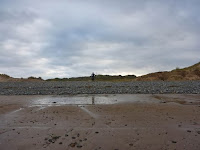Finally the weather has changed to long days of sun. This does however bring with it some challenges for us here at Sandscale.
Although we have been carrying on with our patrols with the police we have still had some people using off road motorbikes and quad bikes to access the dunes. Not only does this have implications for the habitats that are churned up by the bikes but the noise cuts through people’s enjoyment of the reserve. They also speed through families picnicking or building sandcastles without a care for children or dogs running free range.
We hope with the school holidays just around the corner the extra patrols will help to put a stop to these few people that want to spoil it for the rest of us.
Litter also keeps us busy. We’ll be testing to see if adhoc bins on busy weekends are able to concentrate litter in a few places rather than dotted about the place.
We always welcome suggestions and comments from yourselves, so please let us know how we are getting on by taking our visitor survey.
 |
| Luisa drilling holes for the screws |
The change in the weather tends to have a negative impact on the boards of our boardwalk with shrinkage and bending as they dry out. Our volunteers have therefore been deployed on hands and knees to work their way along fixing any that might become a trip hazard. As we lever some up we realise just how rotten the runner boards are underneath so the little job becomes a little larger than first expected. At least it will keep us out of trouble for a while.
 |
| Ok so its a bigger job than we thought, but at least they're still smiling |
All repairs to our electric fence have been carried out as we witnessed the herd of our cows jumping over to get at the lush grass the other side. And since we were all kitted out for fencing we just carried on and fixed the fence at the blow out too (we were on fire!)
We had some amazing visits from youth groups and schools who did some stream dipping and estuary dips, finding over 40 elvers (baby eels) and thousands of shrimps.
As far as other wildlife goes, although we had to cancel the moth trapping public evening, we’ve since done some trapping and caught some awesome hawkmoths as well as 7 other early species.
 |
| Eyed Hawkmoth |
 |
| Poplar Hawkmoth |
Our natterjack toad spawn count is up to 307. We’ve found it particularly hard this year to monitor the natterjacks because the site was still quite flooded at the beginning of the season and therefore the monitoring area was a lot larger than it had ever been before. Also we were finding the odd spawn string every time we were monitoring rather than all at once. We have since found tadpoles in pools that we haven’t had any spawn counted in. For these reasons we believe our final count may be far smaller than the actual numbers
Our orchids aren’t quite out yet which means the orchid survey day has been put back to the 4th July. We still don’t have any records for our coral root orchids yet which came as a great disappointment for all those who travelled to us at the beginning of may for our Coral Root guided walk.
The butterflies are gradually showing themselves with Green veined whites, orange tips, walls and common blues the most regularly seen.
We had some great results for our nesting birds. As we’ve been walking around the reserve we’ve occasionally come across some corkers including eggs from lapwing, snipe, oystercatcher, grey partridge, meadow pipits, tufted duck and coot. We’ve also seen numerous birds carrying food into bushes such as a willow warbler right next to a busy area in the car park. Amazing!
Can you guess the following nests/scrapes?
Unfortunately our owl cam didn’t catch the moment our owl chick fledged and due to technical problems (ie the user) I’ve yet to post the high lights. Which will hopefully come in the next blog so stay tuned...














































